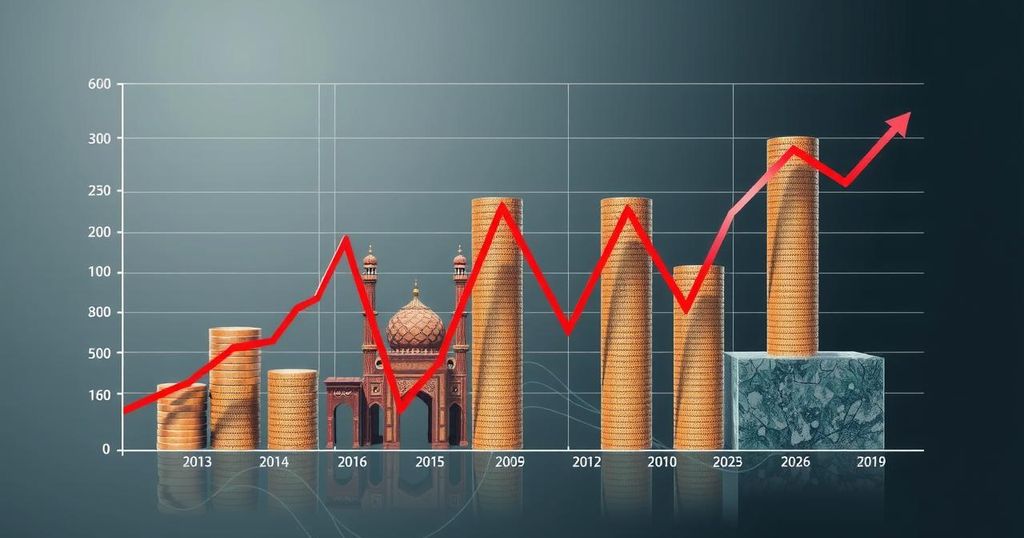Pakistan’s Inflation Dynamics: Understanding Disinflation and Economic Challenges

Pakistan’s inflation peaked at 38 percent in May 2023 but fell to 4.9 percent by December 2024. The SBP raised interest rates to combat inflation before initiating cuts as inflation began to decline. However, 40.5 percent of the population lives below the poverty line, and the interplay between inflation rates and pricing means consumers still face high costs. The reduction in inflation does not equate to lower prices, as purchasing power continues to diminish.
In 2023, Pakistan experienced an alarming rise in inflation, skyrocketing to an unprecedented 38 percent in May. By December 2024, however, inflation had diminished to 4.9 percent, a significant improvement despite the ongoing challenges faced by the nation. The State Bank of Pakistan (SBP) responded to earlier surges by implementing historically high interest rates, peaking at 22 percent, to curb spending and inflationary pressures. Leading into 2024, the SBP enacted its first rate cut in four years, reducing the standard interest rate to 20.5 percent amidst signs of slowing inflation.
Despite improvements in inflation rates, other economic indicators remain concerning. The World Bank reported that 40.5 percent of Pakistan’s population lives below the poverty line, highlighting the severe socio-economic implications of such inflation dynamics. The interplay between inflation rates and average prices is critical, as disinflation—as opposed to deflation—suggests prices are rising, albeit at a slower rate. A detailed assessment shows that, for instance, essential goods like flour have seen minimal price reductions, while other staples like ghee and pulse have experienced price increases, reflecting the complex nature of inflation and consumer spending power.
Miftah Ismail, a former finance minister, emphasized that reduced inflation does not equate to lowered price levels. He stated, “You have to understand that price levels have not gone down, inflation has gone down which only means that the rate at which prices were increasing has fallen.” This statement underlines that while inflation rates may decrease, the purchasing power of consumers is still declining as wages fail to keep pace with ongoing price increases.
The surge in inflation in 2023 was primarily attributed to the government’s previous currency stabilization efforts, which backfired, leading to the rupee’s devaluation and subsequent spike in prices of imported goods. Economists highlighted that inflation had been exacerbated by loose monetary policies and an increase in global fuel prices influenced by geopolitical events, including the conflict in Ukraine.
As inflationary pressures began tapering off, key factors contributing to this shift include a favorable IMF agreement, lowering of international commodity prices, and a significant decrease in domestic demand. Forecasts indicate that inflation might stabilize within the next year if fiscal policies remain stringent, although concerns persist about the volatility of inflation expectations.
The article outlines Pakistan’s inflation trajectory starting from an alarming peak of 38 percent in May 2023, resulting in severe economic repercussions for its populace. Following an IMF bailout aimed at stabilizing Pakistan’s finances, the SBP intervened with aggressive interest rate hikes, reaching up to 22 percent to combat rising inflation. As conditions fluctuated, the central bank began to pivot towards reducing interest rates by mid-2024, signaling a potential ease in economic tightening. While inflation rates decreased, the article critically examines the implications of such changes for the cost of living and overall economic vitality, particularly amidst persistently high poverty rates and gender disparities. The economic discourse centers around the distinction between disinflation—indicating a slowdown in price rises, rather than actual price decreases—and the underlying economic factors that continue to affect purchasing power in Pakistan. The analysis underscores the multifaceted nature of inflation and its connection to broader socio-economic issues.
In conclusion, while Pakistan has made considerable progress in lowering inflation rates from historic highs, the implications for everyday consumers remain complex. The dual challenges of disinflation and persistent price increases illustrate that economic recovery is not merely a matter of reducing inflation figures. Rather, improvements in purchasing power and reductions in poverty are critical for fostering a stable and resilient economy. Going forward, careful monitoring of fiscal policies and continued engagement with international financial institutions will be essential for sustainable economic recovery in Pakistan.
Original Source: www.dawn.com








